These six people turned their homes into sanctuaries for vulnerable animals
Late nights, sweltering temperatures and skyrocketing costs are all part of the job for those who devote their time looking after vulnerable animals. The Advertiser caught up with six people who look after those needing a little extra help with a passion.
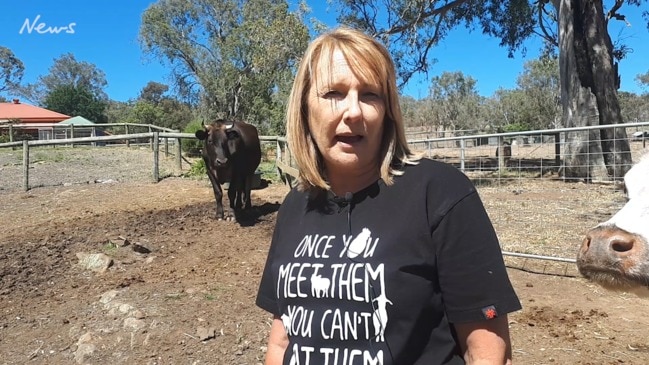
SA News
Don't miss out on the headlines from SA News. Followed categories will be added to My News.
- Animal shelter takes in 15 baby possums after cats and dog attacks
- RSPCA inspectors share stories of their own rescue animals
- How crematoriums are keeping pets’ memories alive
- Native animal sanctuary proposed for Glenthorne Farm
Late nights, sweltering temperatures and skyrocketing feed costs are all part of the job for those who devote their time to the charities and non-profit groups looking after vulnerable animals.
Reporter Michelle Etheridge caught up with six people who have made it their mission to look after those in need of a little extra help.
A happy second life in the hills
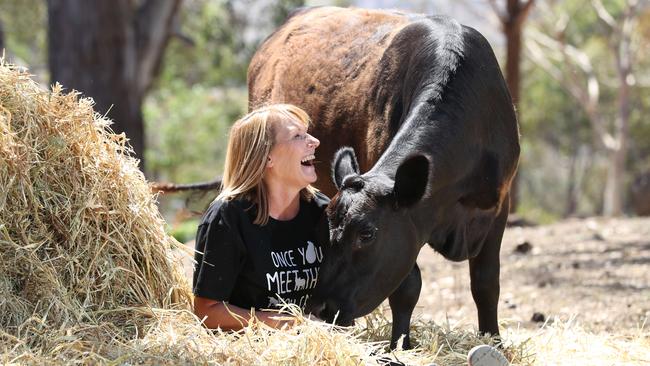
As Kym Henley watched an orphaned lamb play along with her dogs at Crafers, she began to get the feeling her life would take a different turn.
With a 10-acre property, one of her husband Richard’s clients had asked if they had room for the animal at their home.
“We didn’t have a fenced area for him so we had him in with our dogs, and he pushed the ball around and would play with them,” she says.
“I thought, there’s more to these guys … and we sold up and bought a bit more land.”
Now the couple looks after more than 100 former farm and racing animals at their property in Harrogate, in the Adelaide Hills.
“I get tired but it’s not tiring knowing that you’re doing some good,” Mrs Henley says.
“You wake up every morning hoping that you’re doing the right thing and that one day you’ll help change the world, to make for a better world.”
Horses and greyhounds that are unable to race, chickens that have stopped laying eggs and other animals that were orphaned or have health problems, are among the troop now calling Freedom Hill home.
The menagerie has become so large that the Henleys have bought a new property at Monarto, twice the size of their current 50-acre home.
They are preparing to move there later this year, providing more room for the animals and allowing the non-profit organisation to host regular open days and open an education centre on site.
It’s a labour of love for the pair, who are up at 4am each day to start feeding the animals before Mrs Henley heads off to work at 7am.
“When you get your first lamb, it’s like having a baby — you have to do what you do to help it survive,” Mrs Henley says.
“If it means you’re up all night, you’re up all night.
“We’d love to be able to rescue as many farm animals as we can. Each and every one of them has got a different story.”
The organisation has rehomed about 250 animals, but many will live out their days there.
One enclosure is home to 15 turkeys that were anonymously dropped off at the front gate in October when they were poults, or babies.
“If they came from a factory farm, they would have been Christmas lunch,” Mrs Henley says.
Across the property at their house, greyhound Danny was fearful of males when he arrived at their property and crawled on all fours to get to his food.
“He doesn’t like being in the dark,” Mrs Henley says.
“He’s just such a beautiful boy now that he’s come out of his shell and he’s who he should be.”
The organisation receives donations but it’s the couple’s own income — Kym through her work at the Everything Vegan shop on Goodwood Rd, and Richard, through his role as an accountant — that pay the bulk of the operation’s cost.
Those costs skyrocketed during 2018, as feed prices hit the roof during the dry conditions.
“We just have to get through this, and hopefully the winter rains will set in this year,” Mrs Henley says.
Koalas a lifelong passion for animal hospital founder
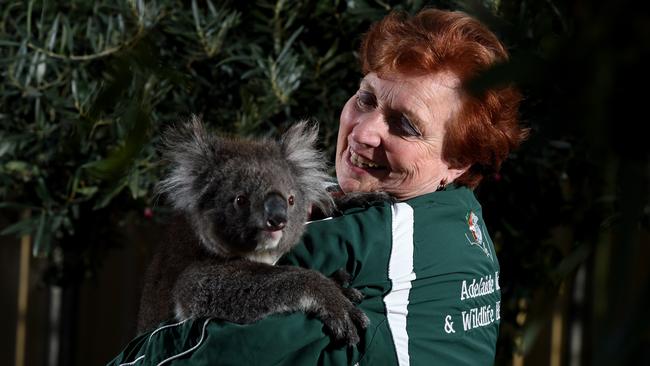
Rae Campbell was just three years old when she started bringing injured and stray animals into her Birdwood home.
“I’m told I brought home anything that didn’t blink twice rapidly,” she says.
“It started with some stray kittens and then it was a bit like topsy and the brood grew and grew with all sorts of things.
“My auntie and uncle who raised me there, were very encouraging and my uncle said you can bring them home if you learn about them.
“I do remember pillow cases hanging around the kitchen with animals that were healing.”
The Trott Park woman, who founded the Adelaide Koala and Wildlife Hospital in 2014, says her “lifelong passion” for koalas started at about 12, when she studied them for a school project.
“Now I’ve got 34 feet of shelves with notes on them,” she says.
“In my time I’ve raised lambs, wombats, emus, wedge-tail eagles, kangaroos, koalas and possums.”
Mrs Campbell’s love for animals also rubbed off onto her husband Warren, who lost a six-year battle with cancer in 2013.
“He died before the hospital opened but we’d been treating animals at our home for many years,” she says.
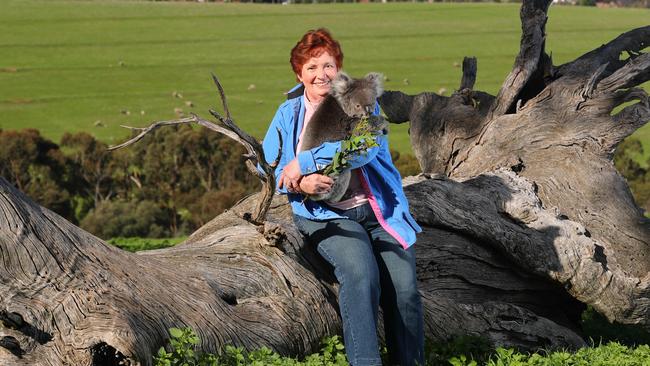
About 40 volunteers help run the Anzac Highway centre, and Mrs Campbell has been able to take a step back from her caring work and instead focus on raising awareness about koalas and how people can help keep them safe in urban environments.
Apart from road accidents, household dogs are one of the marsupials’ biggest threats.
“What dogs do to koalas is just horrendous,” Mrs Campbell says.
“We save one in every 22 koalas presented from dog attacks.”
She shares her home with koala Honey, who she rescued as a 200g joey when her mother was hit by a car on the South Eastern Freeway.
“I’m very honoured because I’m the only person in Australia to be given a permit to keep a koala at home permanently.
“She’s never known any other mum really.”
Next on her agenda is a push to have a native animal centre, and soft release area, built as part of the new Glenthorne Farm National Park in Adelaide’s south.
The State Government is working on plans for the new national park, which will incorporate the 208ha Glenthorne Farm site, along with the Marino and Hallett Cove conservation parks, Field River Valley, Happy Valley Reservoir and O’Halloran Hill Recreation Park.
“Of course, there’s a limited amount of money but I’m quite happy to go out and fundraise to get the equipment,” Mrs Campbell says.
“It would be so beneficial for children and adults to learn about our native wildlife.”
My animals will never know hunger, thirst or predation again

Kangaroo joeys who have fallen victim to road accidents or extreme cases of cruelty are among the pack of more than 50 living out their days at Littlehampton.
Ann Pashley, 75, shares her property with the kangaroos she has rescued and hand-reared during about three decades of voluntary work with the Native Animal Network.
“As far as I’m concerned, they’re the most unique animal in the world,” Mrs Pashley says.
“They’re the most loving creature with the most beautiful eyes — how can you resist them?”
Most of her animals — a mix of euros, red kangaroos, and western greys, eastern greys, have been either hit by cars, or lost their mothers the same way.
“They’ve all got a story and some of them are horrible — there’s one that was shot through the leg. Another jumped over someone’s fence and landed on corrugated iron, and it cut straight down to the bone.”
Mrs Pashley took in Connie from Coonalpyn, after a group of four teenage boys were seen throwing rocks and jumping on her, leaving the western grey with a swollen eye, bleeding nose and swelling on her hind leg.
“My animals will never know hunger, thirst or predation again,” she says.
“We’re getting a lot in really bad condition because of the drought — the animals are very skinny when they come in.”
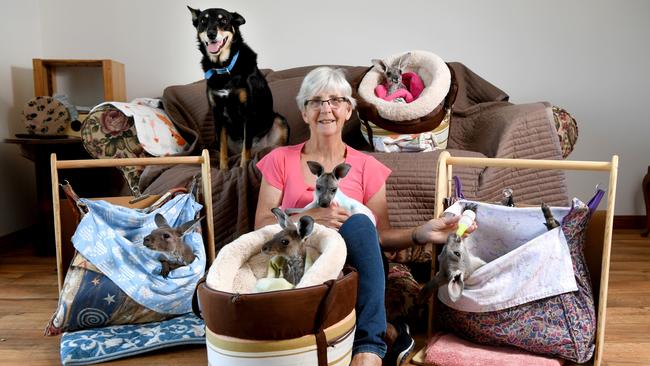
With six joeys in her home, she thinks nothing of sharing her bedroom with the marsupials when they are at their most vulnerable stage.
“When the joeys first come in, they come to bed with me because they’ve lost their mums,” she says.
Others stay in her “joey room”, and once they’re back on their feet, they’re either rehomed or moved outside onto her own property.
“I call the roos and they come up and have a pat and a cuddle,” the Native Animal Network’s president says.
“We don’t believe in releasing these animals because we’ve taken away their biggest defence, and that’s fear of man. Man is their biggest predator.”
It takes at least five hours a day to look after her brood, including bottle-feeding joeys four times.
“I don’t get to bed much before midnight, feeding that lot, and then you’ve got to feed the outside ones as well.”
And it’s not just her time she devotes to her adopted family.
Mrs Pashley, who receives a pension and also lives on superannuation, covers the majority of the cost of her animals’ care out of her own pocket.
“I don’t live a high lifestyle, but I don’t need to — I’ve just got my animals,” she says.
“It can be a really big challenge but I love it — I call my backyard my little piece of heaven.
“It gives me a purpose in life, and I think it’s nice to be needed.”
Wombat saviour’s labour of love
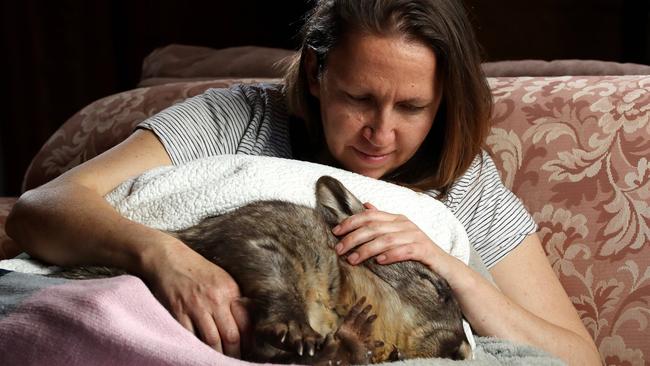
Brigitte Stevens constantly feels jet-lagged providing around-the-clock care for her wombat joey clan — but she wouldn’t have it any other way.
“These babies have their last bottle at midnight and that takes about 1.5 hours to feed them,” Ms Stevens says.
“I get up at about 4.30am or 5am to start another round.
“I try and sleep whenever I get a break but I feel jet-lagged all the time.”
Ms Stevens shares her home — a former hippie commune in Flaxley in the Adelaide Hills — with about 80 wombats.
The Wombat Awareness Organisation founder has morphed the property into a sanctuary for southern hairy-nosed wombats from a range of backgrounds, including those who have been shot and injured, and others at risk of starvation due to dry conditions around the state.
And they’re well looked after.
Most of the wombats live outside in the sanctuary, but the joeys and adults requiring special care can be found sprawling out on beds and blankets inside the organisation’s headquarters.
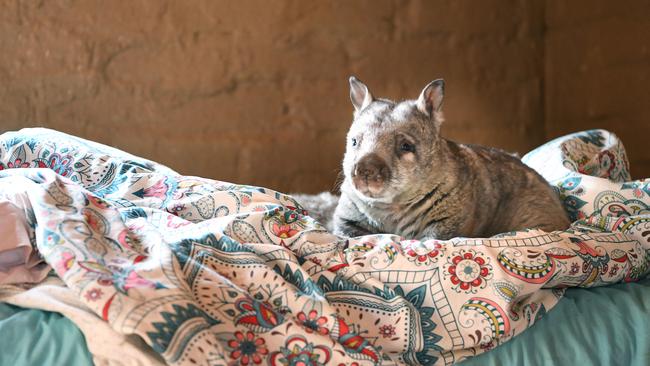
But it’s not only the wombat beds where the marsupials have taken command.
“They sleep wherever they want,” Ms Stevens says.
“I have a bedroom but they’re continuously knocking and knocking.
“I will do anything to get some sleep and so if that involves them sleeping in my bed, they sleep in my bed.”
Ms Stevens was working at a small wildlife park when she took on the care of her first orphaned wombat.
“I realised I didn’t want him to go back in a cage, so I moved back here and started up rescuing and building sanctuaries.”
She launched the Wombat Awareness Organisation in 2006, moving to properties at Rockleigh in the Adelaide Hills, and Mannum, before settling at Flaxley.
Ms Stevens says she and charity partner Clare Jans work for free, looking after their clan, assisting in conservation programs and advocating for the species.
“We don’t want to turn a wombat away — there’s not many alternatives for them that are kind,” Ms Stevens said.
“People think they’re plentiful, but they’re not, if you look at what their habitat was before and what it is now.”
Drive to protect animals inspires couple’s move to the desert

Clint and Kate Taylor have swapped the coast for the desert in their drive to conserve habitat and help save other animals from a similar fate to the Tasmanian tiger.
The couple — Kate from Port Noarlunga and Clint from Newcastle — have been living on Bon Bon Station Reserve in the state’s Far North for almost three years, looking after the 2100sq km conservation area managed by non-profit organisation Bush Heritage.
Kate says as a teenager, she was saddened to learn about the demise of the Tasmanian tiger, or thylacine, which was driven to extinction by hunting and human impacts on its habitat.
“I would see pictures of this really cool animal and realise that we couldn’t even see one of these animals in a zoo anymore,” the reserve’s project field officer says.
“I feel passionate about ensuring that future generations don’t miss out on seeing some of these iconic and unique animals that we have.”

The pair is protecting habitat on the reserve — similar to the size of Greater Sydney — through work such as the eradication of foxes and cats, weed management and studying animals calling the area home.
They include southern hairy-nosed wombats, red kangaroos, western greys, euros, emus, spinifex hopping mice, dunnarts and the chestnut-breasted whiteface bird.
Kate is leading a project to trap small mammals and reptiles, collecting information about the animals and how the reduction of predators is affecting native species.
Clint, the reserve’s manager, says his introduction to conservation was at a small zoo in the Hunter Valley.
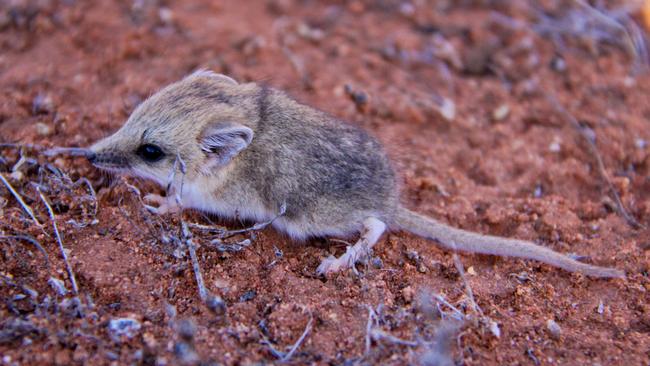
After volunteering in conservation reserves in Africa, he realised his calling was with wild animals.
“There’s a drive to get up and go to work every day — just knowing you’re having a positive impact and trying to make a change and learning about the environment and animals as well,” he says.
“A lot of the animals and systems in the natural environment we don’t know much about, so contributing to knowledge in that space is pretty cool.”
The town nearest to the reserve is an hour away, but features just two service stations and a pub. To get to the closest supermarket, they must travel 180km to Coober Pedy.
“There are homesteads within 30km and we quite often catch up with our neighbours for barbecues and celebrations,” Clint says.
“So although it’s a long way from town, we don’t feel that isolated because we’ve got a supportive community around us.”
michelle.etheridge@news.com.au


